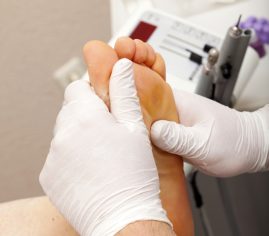The Diabetic Foot
Diabetes is a condition where the amount of glucose in your blood is too high because the body cannot use it properly. This is because the body does not produce any insulin (Type I Diabetes) or not enough insulin, or the insulin that is produced does not work properly (Type II Diabetes).
Diabetes is directly linked with profound changes to your feet. High levels of blood glucose over a long period of time can result in damage to the nerves and the blood vessels in the feet.
Nerve damage is called neuropathy and leads to a loss of sensation. This means that any trauma or injury to the foot may not be felt and this could lead to more serious complications such as an ulcer. Poor blood supply to the feet and legs will affect the ability to heal if there is an injury or a wound on the foot.
You can see how even a seemingly simple problem like corns, callus or poor nail cutting could cause much bigger problems under these circumstances. People with diabetes are more likely to be admitted to hospital with a foot ulcer than with any other complication of diabetes according to information from Diabetes UK.
Podiatry Management
Patients with diabetes need to understand how foot problems develop and how they can be prevented or detected early in order to treat them successfully.
The podiatrist will test for any loss of feeling in the feet and will also check the circulation. Your feet will be checked for any blisters, broken skin, corns, calluses, problem areas or changes in their shape. Your footwear will be checked to see if they are suitable and not causing any problems. You will be told if you are at risk of developing foot problems. If you are at risk we will treat any immediate problems and advise you on the best way to look after your feet and take the necessary precautions to prevent more serious problems such as a diabetic foot ulcer.
Treatment of a foot ulcer has a more successful outcome if treated in the early stages. If they are left untreated, the risks of infection and complications are high. Patients should check daily for any changes or danger signs and seek help immediately. You can also view and download information on how to look after your feet from the Diabetes UK website or the Society of Chiropodist and Podiatrist website.
Download Society of Chiropodists and Podiatrists – Diabetes and your feet (PDF)

